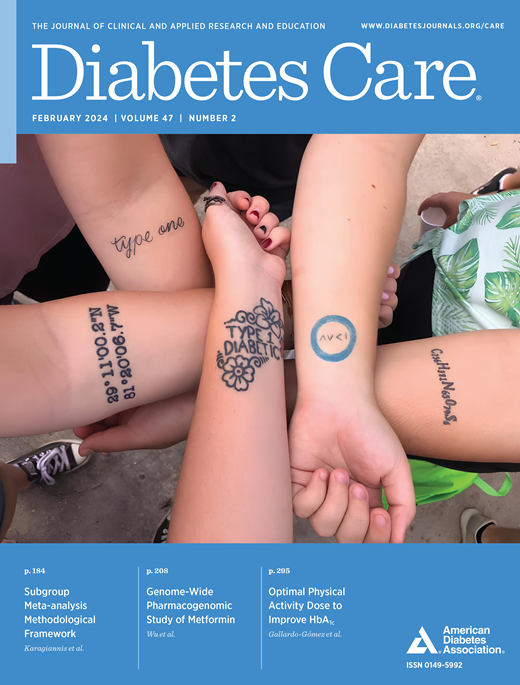β-Cell Function, Incretin Effect, and Glucose Kinetics in Response to a Mixed Meal in Patients With Type 2 Diabetes Treated With Dapagliflozin Plus Saxagliptin
IF 14.8
1区 医学
Q1 ENDOCRINOLOGY & METABOLISM
引用次数: 0
Abstract
OBJECTIVE To explore the complementary effects of a combination of dipeptidyl peptidase 4 and sodium–glucose cotransporter 2 inhibitors added to metformin on hormonal and metabolic responses to meal ingestion. RESEARCH DESIGN AND METHODS Forty-five patients (age 58 ± 8 years; HbA1c 58 ± 6 mmol/mol; BMI 30.7 ± 3.2 kg/m2) with type 2 diabetes uncontrolled with metformin were evaluated at baseline and 3 and 28 days after 5 mg saxagliptin (SAXA), 10 mg dapagliflozin (DAPA), or 5 mg saxagliptin plus 10 mg dapagliflozin (SAXA+DAPA) using a mixed-meal tolerance test (MMTT) spiked with dual-tracer glucose to assess glucose metabolism, insulin secretion, and sensitivity. RESULTS At day 3, fasting and mean MMTT glucose levels were lower with SAXA+DAPA (−31.1 ± 1.6 and −91.5 ± 12.4 mg/dL) than with SAXA (−7.1 ± 2.1 and −53 ± 10.5 mg/dL) or DAPA (−17.0 ± 1.1 and −42.6 ± 10.0 mg/dL, respectively; P < 0.001). Insulin secretion rate (SAXA+DAPA +75%; SAXA +11%; DAPA 3%) and insulin sensitivity (+2.2 ± 1.7, +0.4 ± 0.7, and +0.4 ± 0.4 mg ⋅ kg−1⋅ min−1, respectively) improved with SAXA+DAPA (P < 0.007). Mean glucagon-like peptide 1 (GLP-1) was higher with SAXA+DAPA than with SAXA or DAPA. Fasting glucagon increased with DAPA and SAXA+DAPA but not with SAXA. Fasting endogenous glucose production (EGP) increased with SAXA+DAPA and DAPA. During MMTT, EGP suppression was greater (48%) with SAXA+DAPA (vs. SAXA 44%; P = 0.02 or DAPA 34%; P = 0.2). Metabolic clearance rate of glucose (MCRglu) increased more with SAXA+DAPA. At week 4, insulin secretion rate, β-cell glucose sensitivity, and insulin sensitivity had further increased in the SAXA+DAPA group (P = 0.02), with no additional changes in GLP-1, glucagon, fasting or MMTT EGP, or MCRglu. CONCLUSIONS SAXA+DAPA provided superior glycemic control compared with DAPA or SAXA, with improved β-cell function, insulin sensitivity, GLP-1 availability, and glucose clearance.达帕格列净加沙格列汀治疗的 2 型糖尿病患者对混合餐的β细胞功能、内分泌作用和血糖动力学反应
目的 探讨在二甲双胍基础上联合使用二肽基肽酶 4 和钠-葡萄糖共转运体 2 抑制剂对进餐后激素和代谢反应的互补作用。研究设计与方法 45 名 2 型糖尿病患者(年龄 58 ± 8 岁;HbA1c 58 ± 6 mmol/mol;体重指数 30.7 ± 3.2 kg/m2)进行了基线评估,并在服用 5 毫克沙格列汀 (SAXA)、10 毫克达帕格列净 (DAPA) 或 5 毫克沙格列汀加 10 毫克达帕格列净 (SAXA+DAPA) 3 天和 28 天后进行了双踪葡萄糖混合餐耐受试验 (MMTT),以评估葡萄糖代谢、胰岛素分泌和敏感性。结果 在第 3 天,SAXA+DAPA 的空腹和平均 MMTT 葡萄糖水平(-31.1 ± 1.6 和 -91.5 ± 12.4 mg/dL)低于 SAXA(-7.1 ± 2.1 和 -53 ± 10.5 mg/dL)或 DAPA(分别为 -17.0 ± 1.1 和 -42.6 ± 10.0 mg/dL;P < 0.001)。胰岛素分泌率(SAXA+DAPA +75%;SAXA +11%;DAPA 3%)和胰岛素敏感性(分别为 +2.2±1.7、+0.4±0.7 和 +0.4±0.4 mg ⋅ kg-1⋅ min-1)在 SAXA+DAPA 的作用下有所改善(P &;lt;0.007)。SAXA+DAPA的平均胰高血糖素样肽1(GLP-1)高于SAXA或DAPA。DAPA 和 SAXA+DAPA 会增加空腹胰高血糖素,而 SAXA 不会。SAXA+DAPA 和 DAPA 会增加空腹内源性葡萄糖生成量(EGP)。在 MMTT 期间,SAXA+DAPA 的 EGP 抑制率更高(48%)(与 SAXA 44%; P = 0.02 或 DAPA 34%; P = 0.2 相比)。SAXA+DAPA的葡萄糖代谢清除率(MCRglu)增加得更多。第 4 周时,SAXA+DAPA 组的胰岛素分泌率、β 细胞葡萄糖敏感性和胰岛素敏感性进一步提高(P = 0.02),而 GLP-1、胰高血糖素、空腹或 MMTT EGP 或 MCRglu 均无额外变化。结论 SAXA+DAPA 的血糖控制效果优于 DAPA 或 SAXA,β 细胞功能、胰岛素敏感性、GLP-1 利用率和葡萄糖清除率均有所改善。
本文章由计算机程序翻译,如有差异,请以英文原文为准。
求助全文
约1分钟内获得全文
求助全文
来源期刊

Diabetes Care
医学-内分泌学与代谢
CiteScore
27.80
自引率
4.90%
发文量
449
审稿时长
1 months
期刊介绍:
The journal's overarching mission can be captured by the simple word "Care," reflecting its commitment to enhancing patient well-being. Diabetes Care aims to support better patient care by addressing the comprehensive needs of healthcare professionals dedicated to managing diabetes.
Diabetes Care serves as a valuable resource for healthcare practitioners, aiming to advance knowledge, foster research, and improve diabetes management. The journal publishes original research across various categories, including Clinical Care, Education, Nutrition, Psychosocial Research, Epidemiology, Health Services Research, Emerging Treatments and Technologies, Pathophysiology, Complications, and Cardiovascular and Metabolic Risk. Additionally, Diabetes Care features ADA statements, consensus reports, review articles, letters to the editor, and health/medical news, appealing to a diverse audience of physicians, researchers, psychologists, educators, and other healthcare professionals.
 求助内容:
求助内容: 应助结果提醒方式:
应助结果提醒方式:


